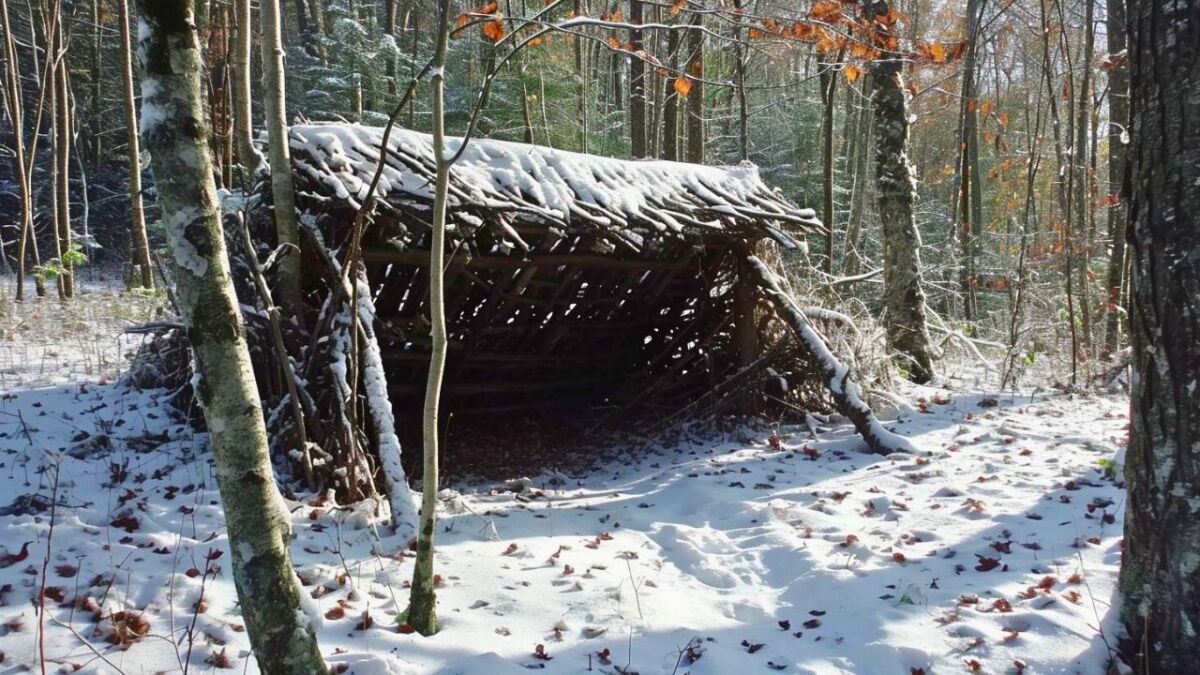
Shelter
Noun
Meaning
A shelter is a crucial element in survival, bushcraft, and outdoor activities such as camping and hiking. It refers to a structure or a place that provides protection and refuge from the elements, including rain, wind, and extreme temperatures. In the wilderness, a shelter can be anything from a simple tarp or a makeshift lean-to to a more elaborate structure like a tent or a natural debris shelter. Building a shelter is an essential skill for anyone venturing into the outdoors, as it ensures safety, comfort, and the ability to withstand adverse conditions.

Examples
„When I was lost in the wilderness, finding shelter was my top priority. I quickly built a makeshift shelter using fallen tree branches and a tarp I had in my backpack.“
„During our survival training, we learned how to construct different types of shelters, such as lean-tos and debris huts. It's important to know how to build a shelter in various environments to protect yourself from the elements.“
„After a long day of hiking, I was relieved to find a cozy shelter in the form of a mountain cabin. It provided a warm and dry place to rest and recharge before continuing my journey.“
„In a survival situation, a shelter can mean the difference between life and death. It not only protects you from harsh weather conditions but also provides a sense of security and comfort in the wilderness.“
„I found a great spot in the woods to build a shelter for our camping trip. It's protected from the wind and has plenty of branches and leaves to use as insulation.“
„When I was lost in the wilderness, finding shelter was my top priority. I quickly built a makeshift lean-to using fallen branches and a tarp I had in my backpack.“
„During our survival training, we learned how to construct different types of shelters, such as debris huts and snow caves. It's essential to know how to adapt to different environments and create a secure shelter.“
„In a survival situation, finding natural shelters like caves or rock overhangs can be a lifesaver. They provide immediate protection from the elements and can save you time and energy in building a shelter from scratch.“
„When hiking in the mountains, it's crucial to carry a lightweight emergency shelter, such as a bivy sack or a tarp. You never know when bad weather or an injury might leave you stranded overnight.“
Origin
The word "shelter" originates from the Old English word "scield" which means "shield" or "protection". It has its roots in the Proto-Germanic language and can be traced back to the Proto-Indo-European word "skel-", meaning "to cover" or "to hide".
Throughout history, the concept of shelter has been essential for human survival. In ancient times, people sought refuge in caves, rock shelters, and natural formations to protect themselves from the elements and wild animals.
As civilization developed, humans began constructing more permanent shelters using materials such as wood, stone, and clay. The design and construction of shelters evolved to meet the specific needs of different cultures and environments.
In the context of survival and bushcraft, a shelter refers to a temporary structure or improvised dwelling that provides protection and comfort in the wilderness. It can range from a simple lean-to made from branches and leaves to a more elaborate structure like a debris hut or a tarp shelter.
Shelters serve as a crucial element in survival situations, offering protection from extreme weather conditions, predators, and providing a sense of security. They are an essential skill for anyone venturing into the wilderness, as they can mean the difference between life and death.
Synonyms
Hideout, Safe haven, Shelter, Refuge, Haven, Sanctuary, Protection, Cover, Lodging, Accommodation
Antonyms
Unsafe, Exposed, Unprotected, Vulnerable, Open, Uncovered, Defenseless, Unsheltered, Bare
Relatives
Wilderness, Bushcraft, Camping, Outdoor, Nature, Protection
Historical and cultural importance
Shelter is a word that holds great historical and cultural significance in the realm of survival and bushcraft. Throughout history, humans have relied on shelters to protect themselves from the elements and provide a safe haven in the wilderness.
In ancient times, our ancestors used natural materials such as leaves, branches, and animal hides to construct makeshift shelters. These structures not only provided protection from harsh weather conditions but also served as a place to rest, cook, and socialize.
Shelters have played a crucial role in various cultures around the world. For example, Native American tribes built teepees, which were portable and easy to assemble, using buffalo hides and wooden poles. Inuit communities in the Arctic constructed igloos, dome-shaped snow shelters, to withstand freezing temperatures.
Throughout history, shelters have also been associated with survival skills and the ability to adapt to different environments. Explorers and adventurers, such as the early pioneers and mountaineers, relied on their knowledge of shelter-building techniques to survive in remote and challenging landscapes.
Today, the importance of shelters remains unchanged in the world of survival. Whether it's a simple lean-to made from branches or a modern lightweight tent, having a reliable shelter is essential for anyone venturing into the wilderness. It provides protection from rain, wind, and extreme temperatures, ensuring your safety and well-being.
Understanding the historical and cultural relevance of shelters helps us appreciate the ingenuity and resourcefulness of our ancestors. It also reminds us of the fundamental role that shelters play in our survival and connection to the natural world.
More information about the term Shelter
Shelter: Finding Refuge in the Wilderness
When venturing into the wilderness, one of the most crucial skills to possess is the ability to create a shelter. In the unpredictable and often harsh conditions of nature, having a safe and secure place to rest and protect yourself from the elements is essential for survival. Let's explore the different types of shelters you can construct in the wild.
Natural Shelters: Utilizing the Environment
One of the first things I learned about survival is that nature provides us with an abundance of resources to create shelters. From caves and rock formations to fallen trees and dense foliage, the wilderness offers a variety of natural shelters that can be utilized in emergencies. These shelters provide immediate protection and require minimal effort to construct.
However, it's important to assess the safety and stability of natural shelters before settling in. Always be cautious of potential hazards such as loose rocks, unstable branches, or animal dens. Additionally, consider the proximity to water sources and the risk of flooding during heavy rain.
Debris Huts: A Reliable Wilderness Shelter
One of my favorite types of shelters to build in the wild is the debris hut. This simple yet effective structure is constructed using natural materials such as branches, leaves, and moss. The debris hut provides insulation and protection from wind, rain, and cold temperatures.
To build a debris hut, start by creating a sturdy framework using long branches or saplings. Then, layer smaller branches and foliage on top, leaving a small entrance for easy access. Finally, cover the entire structure with a thick layer of leaves and moss to provide insulation.
Tarp Shelters: Lightweight and Versatile
For those who prefer a more portable and versatile shelter option, tarps are an excellent choice. Lightweight and easy to pack, tarps can be set up in various configurations depending on the terrain and weather conditions.
To create a tarp shelter, start by finding two sturdy anchor points such as trees or rocks. Attach one end of the tarp to each anchor point, ensuring it is pulled taut. Then, secure the sides of the tarp to the ground using stakes or rocks. This setup provides a reliable shelter that can withstand wind and rain.
Snow Shelters: Surviving in Winter Conditions
In snowy environments, knowing how to build a snow shelter can be a lifesaver. Snow caves, snow trenches, and igloos are all effective options for staying warm and protected from the cold.
To build a snow cave, start by digging into a snowbank or drift. Create a small entrance tunnel that leads to a larger interior space. This design helps trap warm air inside while keeping cold air out. Remember to create ventilation holes to prevent carbon dioxide buildup.
Conclusion
When it comes to survival in the wilderness, having the knowledge and skills to construct a shelter is paramount. Whether you rely on natural shelters, debris huts, tarp shelters, or snow shelters, the ability to find refuge in the wild can mean the difference between life and death. So, embrace the challenge, learn the techniques, and always prioritize your shelter-building skills when venturing into the great outdoors.
Back to overview

